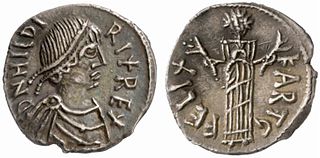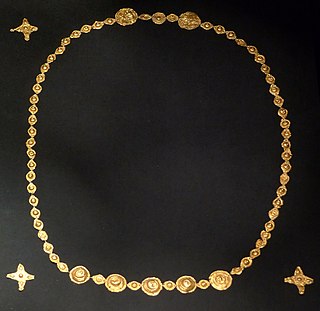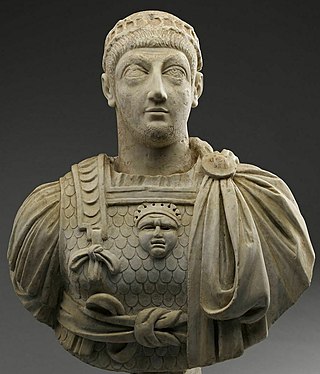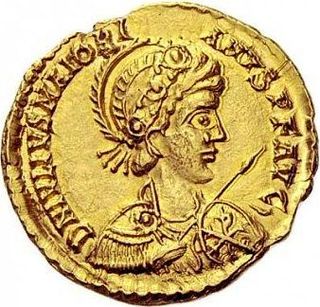The 430s decade ran from January 1, 430, to December 31, 439.
The 420s decade ran from January 1, 420, to December 31, 429.
The 450s decade ran from January 1, 450, to December 31, 459.

Year 440 (CDXL) was a leap year starting on Monday of the Julian calendar. At the time, it was known as the Year of the Consulship of Valentinianus and Anatolius. The denomination 440 for this year has been used since the early medieval period, when the Anno Domini calendar era became the prevalent method in Europe for naming years

Year 439 (CDXXXIX) was a common year starting on Sunday of the Julian calendar. At the time, it was known as the Year of the Consulship of Theodosius and Festus. The denomination 439 for this year has been used since the early medieval period, when the Anno Domini calendar era became the prevalent method in Europe for naming years.
The 440s decade ran from January 1, 440, to December 31, 449.

Year 455 (CDLV) was a common year starting on Saturday of the Julian calendar. At the time, it was known as the Year of the Consulship of Valentinianus and Anthemius. The denomination 455 for this year has been used since the early medieval period, when the Anno Domini calendar era became the prevalent method in Europe for naming years.

Hilderic was the penultimate king of the Vandals and Alans in North Africa in Late Antiquity (523–530). Although dead by the time the Vandal Kingdom was overthrown in 534, he nevertheless played a key role in that event.

The Vandals were a Germanic people who first inhabited what is now southern Poland. They established Vandal kingdoms on the Iberian Peninsula, Mediterranean islands, and North Africa in the fifth century.

Valentinian III was Roman emperor in the West from 425 to 455. Made emperor in childhood, his reign over the Roman Empire was one of the longest, but was dominated by powerful generals vying for power amid civil wars and the invasions of Late antiquity's Migration Period, including the campaigns of Attila the Hun.

Majorian, was the Western Roman emperor from 457 to 461. A prominent commander in the Western military, Majorian deposed Avitus in 457 with the aid of his ally Ricimer. Possessing little more than Italy, Dalmatia, as well as some territory in Hispania and northern Gaul, Majorian campaigned rigorously for three years against the Empire's enemies. In 461, he was murdered at Dertona in a conspiracy, and his successors until the Fall of the Empire in 476 were puppets either of barbarian generals or the Eastern Roman court.

Petronius Maximus was Roman emperor of the West for two and a half months in 455. A wealthy senator and a prominent aristocrat, he was instrumental in the murders of the Western Roman magister militum, Aëtius, and the Western Roman emperor, Valentinian III.

Licinia Eudoxia was a Roman Empress, daughter of Eastern Roman Emperor Theodosius II. Her husbands included the Western Roman Emperors Valentinian III and Petronius Maximus.

The sack of Rome in 455 AD marked a pivotal moment in European history when the Vandals, a Germanic tribe led by King Genseric, invaded the city. The Vandals pillaged the city for two weeks, causing widespread destruction. The event, following the Visigothic sack of 410, shocked the Roman world and symbolized the decline and impending fall of the Western Roman Empire.
Gaiseric, also known as Geiseric or Genseric was king of the Vandals and Alans from 428 to 477. He ruled over a kingdom and played a key role in the decline of the Western Roman Empire during the 5th century.
Restless Heart: The Confessions of Saint Augustine is a 2010 two-part television miniseries chronicling the life of St. Augustine, the early Christian theologian, writer and Bishop of Hippo Regius at the time of the Vandal invasion.

The Vandal Kingdom or Kingdom of the Vandals and Alans was a confederation of Vandals and Alans, which is one of the barbarian kingdoms established under Gaiseric, a Vandal warrior. It ruled in North Africa and the Mediterranean from 435 to 534 AD.

Revenge of The Gladiators is a 1964 Italian peplum film written and directed by Luigi Capuano and starring Mickey Hargitay and José Greci.
Vaga, Vecca and lately Theodorias is an ancient city in Tunisia built by the Berbers and ruled sequentially by the Carthaginians, the Numidians, the Romans, the Vandals and the Byzantines until it was captured by the Arabs who changed its name to the present day Béja. The town was the capital of the Numidian Kingdom during the rule of Jugurtha.

Carthage was captured by the Vandals from the Western Roman Empire on 19 October 439. Under their leader Genseric, the Vandals crossed the Strait of Gibraltar into Africa and captured Hippo Regius in August 431, which they made the capital of their kingdom. Despite an uneasy peace with the Romans, Genseric made a surprise attack against Carthage in October 439. After capturing Carthage, the Vandals put the city to the sack and made it the new capital of their kingdom.











